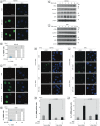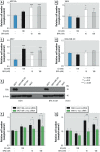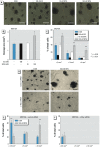Effects of Low-Dose Bisphenol A on DNA Damage and Proliferation of Breast Cells: The Role of c-Myc
- PMID: 25933419
- PMCID: PMC4671234
- DOI: 10.1289/ehp.1409199
Effects of Low-Dose Bisphenol A on DNA Damage and Proliferation of Breast Cells: The Role of c-Myc
Abstract
Background: Humans are exposed to low-dose bisphenol A (BPA) through plastic consumer products and dental sealants containing BPA. Although a number of studies have investigated the mammary gland effects after high-dose BPA exposure, the study findings differ. Furthermore, there has been a lack of mechanistic studies.
Objective: The objective of this study was to investigate the effect and the mechanism of low-dose BPA in mammary gland cells.
Methods: We evaluated DNA damage following BPA exposure using the comet assay and immunofluorescence staining, and used cell counting and three-dimensional cultures to evaluate effects on proliferation. We examined the expressions of markers of DNA damage and cell-cycle regulators by immunoblotting and performed siRNA-mediated gene silencing to determine the role of c-Myc in regulating BPA's effects.
Results: Low-dose BPA significantly promoted DNA damage, up-regulated c-Myc and other cell-cycle regulatory proteins, and induced proliferation in parallel in estrogen receptor-α (ERα)-negative mammary cells. Silencing c-Myc diminished these BPA-induced cellular events, suggesting that c-Myc is essential for regulating effects of BPA on DNA damage and proliferation in mammary cells.
Conclusions: Low-dose BPA exerted c-Myc-dependent genotoxic and mitogenic effects on ERα-negative mammary cells. These findings provide significant evidence of adverse effects of low-dose BPA on mammary cells.
Conflict of interest statement
The authors declare they have no actual or potential competing financial interests.
Figures






Comment in
-
Examining BPA's Mechanisms of Action: The Role of c-Myc.Environ Health Perspect. 2015 Dec;123(12):A304. doi: 10.1289/ehp.123-A304. Environ Health Perspect. 2015. PMID: 26623713 Free PMC article. No abstract available.
Similar articles
-
Examining BPA's Mechanisms of Action: The Role of c-Myc.Environ Health Perspect. 2015 Dec;123(12):A304. doi: 10.1289/ehp.123-A304. Environ Health Perspect. 2015. PMID: 26623713 Free PMC article. No abstract available.
-
Effect of bisphenol A on morphology, apoptosis and proliferation in the resting mammary gland of the adult albino rat.Int J Exp Pathol. 2016 Feb;97(1):27-36. doi: 10.1111/iep.12164. Epub 2016 Feb 15. Int J Exp Pathol. 2016. PMID: 26877094 Free PMC article.
-
Effect of low dose bisphenol A on the early differentiation of human embryonic stem cells into mammary epithelial cells.Toxicol Lett. 2013 Apr 26;218(3):187-93. doi: 10.1016/j.toxlet.2013.01.026. Epub 2013 Feb 4. Toxicol Lett. 2013. PMID: 23391485
-
Bisphenol A co-exposure effects: a key factor in understanding BPA's complex mechanism and health outcomes.Crit Rev Toxicol. 2019 May;49(5):371-386. doi: 10.1080/10408444.2019.1621263. Epub 2019 Jul 1. Crit Rev Toxicol. 2019. PMID: 31256736 Free PMC article. Review.
-
Alteration of mammary gland development by bisphenol a and evidence of a mode of action mediated through endocrine disruption.Mol Cell Endocrinol. 2018 Nov 5;475:29-53. doi: 10.1016/j.mce.2018.06.015. Epub 2018 Jul 23. Mol Cell Endocrinol. 2018. PMID: 30048677 Review.
Cited by
-
Sex-specific expression of the human NAFLD-NASH transcriptional signatures in the liver of medaka with a history of ancestral bisphenol A exposure.bioRxiv [Preprint]. 2024 May 21:2024.05.19.594843. doi: 10.1101/2024.05.19.594843. bioRxiv. 2024. PMID: 38826193 Free PMC article. Preprint.
-
Transcriptome-Wide Analysis of Low-Concentration Exposure to Bisphenol A, S, and F in Prostate Cancer Cells.Int J Mol Sci. 2023 May 30;24(11):9462. doi: 10.3390/ijms24119462. Int J Mol Sci. 2023. PMID: 37298413 Free PMC article.
-
A comprehensive study on bisphenol A degradation by newly isolated strains Acinetobacter sp. K1MN and Pseudomonas sp. BG12.Biodegradation. 2021 Feb;32(1):1-15. doi: 10.1007/s10532-020-09919-6. Epub 2020 Nov 17. Biodegradation. 2021. PMID: 33205349 Free PMC article.
-
Combined Effects of High-Dose Bisphenol A and Oxidizing Agent (KBrO3) on Cellular Microenvironment, Gene Expression, and Chromatin Structure of Ku70-deficient Mouse Embryonic Fibroblasts.Environ Health Perspect. 2016 Aug;124(8):1241-52. doi: 10.1289/EHP237. Epub 2016 Apr 15. Environ Health Perspect. 2016. PMID: 27082013 Free PMC article.
-
White rot fungi can be a promising tool for removal of bisphenol A, bisphenol S, and nonylphenol from wastewater.Environ Sci Pollut Res Int. 2020 Nov;27(32):39958-39976. doi: 10.1007/s11356-020-10382-2. Epub 2020 Aug 15. Environ Sci Pollut Res Int. 2020. PMID: 32803603 Free PMC article. Review.
References
-
- Audebert M, Dolo L, Perdu E, Cravedi JP, Zalko D. Use of the γH2AX assay for assessing the genotoxicity of bisphenol A and bisphenol F in human cell lines. Arch Toxicol. 2011;85:1463–1473. - PubMed
-
- Bakkenist CJ, Kastan MB. Initiating cellular stress responses. Cell. 2004;118:9–17. - PubMed
-
- Boyd M, Hildebrandt RH, Bartow SA. Expression of the estrogen receptor gene in developing and adult human breast. Breast Cancer Res Treat. 1996;37:243–251. - PubMed
Publication types
MeSH terms
Substances
Grants and funding
LinkOut - more resources
Full Text Sources
Other Literature Sources

